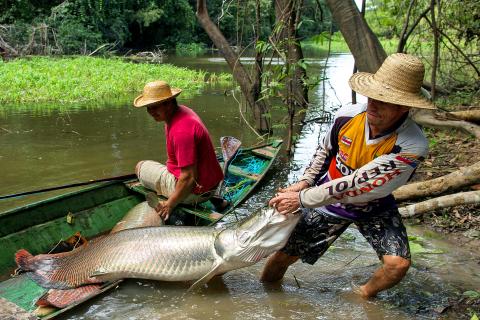Its white flesh is tender and tasty, it can measure up to 3m long and weigh more than 200kg: Meet the pirarucu, one of the world’s largest freshwater fish that is native to the Amazon.
The enormous animal, once threatened with extinction, is now on dinner plates in Rio de Janeiro’s fanciest restaurants, thanks to a number of chefs who have championed the delicacy and the indigenous communities who ensure its continued survival.
“Without them, there would be nothing left,” said Frederic Monnier, the head chef at the city’s hip Brasserie Rosario.

Photo: Reuters
“What they’re doing for the Amazon is priceless,” added Jessica Trindade, the Brazilian chef at Chez Claude, an institution in the city’s restaurant scene.
Chef Marcelo Barcellos uses pirarucu in his moqueca, a fish stew swimming in palm oil and seasoned with coriander that is a signature Brazilian dish originating in the northeastern state of Bahia.
Served with a toasted cassava flour mixture and nuts that come straight from the Amazon basin, the moqueca delights foodies’ taste buds and eyes, as the white fish contrasts with the yellow flour and green spices.
The taste is akin to that of other saltwater whitefish like pollock or cod.
Barcellos, the executive chef and owner of the restaurant Barsa, is one of several Rio de Janeiro chefs who have happily added pirarucu to his menu.
However, not that long ago, before pirarucu made it to the top tables in the “Marvelous City,” Arapaima gigas — or Amazonian cod, as it is sometimes called — almost vanished from menus.
It was brought back from the brink of extinction thanks to the establishment at a nature preserve of a sustainable fishing program with strict quotas. Pirarucu can only be fished from July to November, the non-mating season.
Raising the pirarucu’s profile with Rio de Janeiro’s top chefs has certainly helped.
The Taste of the Amazon project has helped do that. Recently, nine chefs traveled to northern Brazil to observe how the Paumari community has established sustainable practices for harvesting pirarucu.
Through their contact with the indigenous fishermen, the chefs learned which parts of the fish are the best. That knowledge ended up on their menus.
“It’s an excellent product, with a fabulous flavor, without that earthy taste that some freshwater fish have,” Trindade said.
For Ricardo Lapeyre of the Michelin-starred Laguiole Lab, the experience surpassed his expectations.
He figured he would take the trip just to learn a bit more about how to cook the fish and bring some new ingredients back to his kitchen. In the end, he is on board the pirarucu train, and is one of its biggest fans.
“It’s a superior fish — the quality is largely superior to what we get from fish farms,” he said. “I became aware of the importance of the forest and the support given to projects that benefit local populations.”
Adevaldo Dias, an official at ASPROC, the cooperative that manages the sustainable fishing of the pirarucu, was pleasantly surprised with how interested the chefs were to take part in the project.
“I was struck by their commitment, their understanding of how this fish is good for the Amazon and the need to pay fishermen properly,” Dias said.
The sustainable fishing project for the pirarucu was put in place 20 years ago.
Since then, the giant fish population has soared, from about 2,500 in 1999 to more than 190,000 last year.
Thanks to ASPROC, the fishermen are paid 7 reais (US$1.75) per kilo, compared with the 4 reais they could count on by selling in local markets.
However, restaurants pay a whopping 48 reais per kilo because of transportation costs. The dish is then sold for about 70 reais.
Leonardo Kurihara — the coordinator of Operation Native Amazon (OPAN), which is overseeing the Taste of the Amazon initiative — said that chefs are vital, because “they are at the other end of the chain, presenting the product to the consumer.”
Felipe Rossoni, another OPAN official, said that the initiative has cleared the way for new markets for the pirarucu.
“Sustainable fishing helps preserve the environment, and reinforces the autonomy and clear identity of traditional communities,” Rossoni said.

CHIP RACE: Three years of overbroad export controls drove foreign competitors to pursue their own AI chips, and ‘cost US taxpayers billions of dollars,’ Nvidia said China has figured out the US strategy for allowing it to buy Nvidia Corp’s H200s and is rejecting the artificial intelligence (AI) chip in favor of domestically developed semiconductors, White House AI adviser David Sacks said, citing news reports. US President Donald Trump on Monday said that he would allow shipments of Nvidia’s H200 chips to China, part of an administration effort backed by Sacks to challenge Chinese tech champions such as Huawei Technologies Co (華為) by bringing US competition to their home market. On Friday, Sacks signaled that he was uncertain about whether that approach would work. “They’re rejecting our chips,” Sacks

NATIONAL SECURITY: Intel’s testing of ACM tools despite US government control ‘highlights egregious gaps in US technology protection policies,’ a former official said Chipmaker Intel Corp has tested chipmaking tools this year from a toolmaker with deep roots in China and two overseas units that were targeted by US sanctions, according to two sources with direct knowledge of the matter. Intel, which fended off calls for its CEO’s resignation from US President Donald Trump in August over his alleged ties to China, got the tools from ACM Research Inc, a Fremont, California-based producer of chipmaking equipment. Two of ACM’s units, based in Shanghai and South Korea, were among a number of firms barred last year from receiving US technology over claims they have

It is challenging to build infrastructure in much of Europe. Constrained budgets and polarized politics tend to undermine long-term projects, forcing officials to react to emergencies rather than plan for the future. Not in Austria. Today, the country is to officially open its Koralmbahn tunnel, the 5.9 billion euro (US$6.9 billion) centerpiece of a groundbreaking new railway that will eventually run from Poland’s Baltic coast to the Adriatic Sea, transforming travel within Austria and positioning the Alpine nation at the forefront of logistics in Europe. “It is Austria’s biggest socio-economic experiment in over a century,” said Eric Kirschner, an economist at Graz-based Joanneum

OPTION: Uber said it could provide higher pay for batch trips, if incentives for batching is not removed entirely, as the latter would force it to pass on the costs to consumers Uber Technologies Inc yesterday warned that proposed restrictions on batching orders and minimum wages could prompt a NT$20 delivery fee increase in Taiwan, as lower efficiency would drive up costs. Uber CEO Dara Khosrowshahi made the remarks yesterday during his visit to Taiwan. He is on a multileg trip to the region, which includes stops in South Korea and Japan. His visit coincided the release last month of the Ministry of Labor’s draft bill on the delivery sector, which aims to safeguard delivery workers’ rights and improve their welfare. The ministry set the minimum pay for local food delivery drivers at